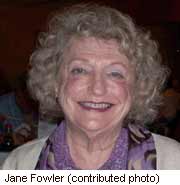
WEDNESDAY, Dec. 1 (HealthDay News) — One January day in 1991, career journalist Jane Fowler, then 55, opened a letter from a health insurance company informing her that her request for coverage had been denied due to a “significant blood abnormality.”
This was the first inkling — later confirmed in her doctor’s office — that the Kansas City, Kan., native had contracted HIV from someone she had dated five years before, a man she’d been friends with her entire adult life. She had begun seeing him two years after the end of her 24-year marriage.
Fowler, now 75 and healthy thanks to the advent of antiretroviral medications, recalls being devastated by her diagnosis.
“I went home that day and literally took to my bed. I thought, ‘What’s going to happen?'” she said. For the next four years Fowler, once an active and successful writer and editor, lived in what she called “semi-isolation,” staying mostly in her apartment.
Then came the dawning realization that her isolation wasn’t helping anyone, least of all herself.
Fowler slowly began reaching out to experts and other older Americans to learn more about living with HIV in life’s later decades. By 1995, she had helped co-found the National Association on HIV Over 50. And through her program, HIV Wisdom for Older Women, Fowler today speaks to audiences nationwide on the challenges of living with the virus.
“I decided to speak out — to put an old, wrinkled, white, heterosexual face to this disease,” she said. “But my message isn’t age-specific: We all need to understand that we can be at risk.”
That message may be more urgent than ever this Wednesday, World AIDS Day. During a recent White House forum on HIV and aging, at which Fowler spoke, experts presented new data suggesting that as the HIV/AIDS epidemic enters its fourth decade those afflicted by it are aging, too.
One report, conducted by the AIDS Community Research Initiative of America (ACRIA), noted that 27 percent of Americans diagnosed with HIV are now aged 50 or older and by 2015 that percentage could double.
Why? According to Dr. Michael Horberg, vice chair of the HIV Medicine Association, there’s been a societal “perfect storm” that’s led to more HIV infections among people in middle age or older.
“Certainly the rise of Viagra and similar drugs to treat erectile dysfunction, people are getting more sexually active because they are more able to do so,” Horberg said. There’s also the perception that HIV is now treatable with complex drug regimens, he said, even though these medicines often come with onerous side effects.
For her part, Fowler said that more and more aging Americans find themselves recently divorced (as she did) or widowed and back in the dating game.
And all too often, doctors fail to appreciate that their patients over 50 might still have active sex lives, so the possibility of sexually transmitted diseases is often overlooked.
“Often, they’re tested [for HIV] too late,” Fowler said. “Many have already been diagnosed with full-blown AIDS. In fact, that’s often how the diagnosis comes.” At that point, it’s much tougher for AIDS drugs to do their job of suppressing HIV.
Aging with HIV presents other problems, as well. According to ACRIA’s survey of about 1,000 HIV-positive men and women, 91 percent are battling other chronic medical conditions associated with age, including arthritis, neuropathies and high blood pressure. Many are coping with these conditions on their own: 70 percent of older Americans with HIV live alone, the report found, more than twice the rate of their non-infected contemporaries.
Adding HIV and its often potent drug treatment to the usual troubles of aging can be tough. Speaking at the White House conference, Dr. Amy Justice, principal investigator of the Veterans Aging Cohort Study, which involves more than 40,000 veterans with HIV, said: “There are a lot of [infected] people who are 60 or 65 or even 80 or 85. These people feel older than their stated age and may have some of the same problems people 10 or 15 years older would normally experience.”
According to Horberg, many of the diseases of aging “are made worse by HIV or its treatment.” For example, he said, the AIDS drug tenofovir can impair kidney function, other antiretrovirals cannot be taken with cholesterol-lowering drugs such as Zocor or Mevacor, and it’s suspected that HIV infection might even accelerate the onset of Alzheimer’s disease.
Issues of HIV prevention and treatment can be especially tough on older women, said Diane Zablotsky, an associate professor of sociology at the University of North Carolina who’s worked on the issue.
In terms of prevention, she noted that it may be tougher for a woman past menopause to negotiate condom use with a partner, when pregnancy is no longer an issue. And in terms of diagnosis and treatment, “if you have a woman experiencing night sweats and other kinds of symptoms — is that menopausal change? A medication issue? Or is it an HIV-infection issue?”
All of the experts stressed that the key to curbing HIV infection in older Americans is the same as it is for the young: prevention. But that will mean having much franker discussions about sex.
“There’s this myth that older people aren’t sexually active,” Fowler said. “Health-care providers could help by taking sexual histories, but they don’t because they assume they don’t have to. They can ask about smoking and alcohol use, but sex? Oh no, the person is old.”
Zablotsky agreed. “The important thing is to reach out to older people in a way which — if in fact they are engaging in behavior that puts them at risk — they have a reason to say, ‘I need to listen to this, I need to make this change, I need to protect myself.'”
More information
Find out more at ACRIA’s Center on HIV & Aging.

